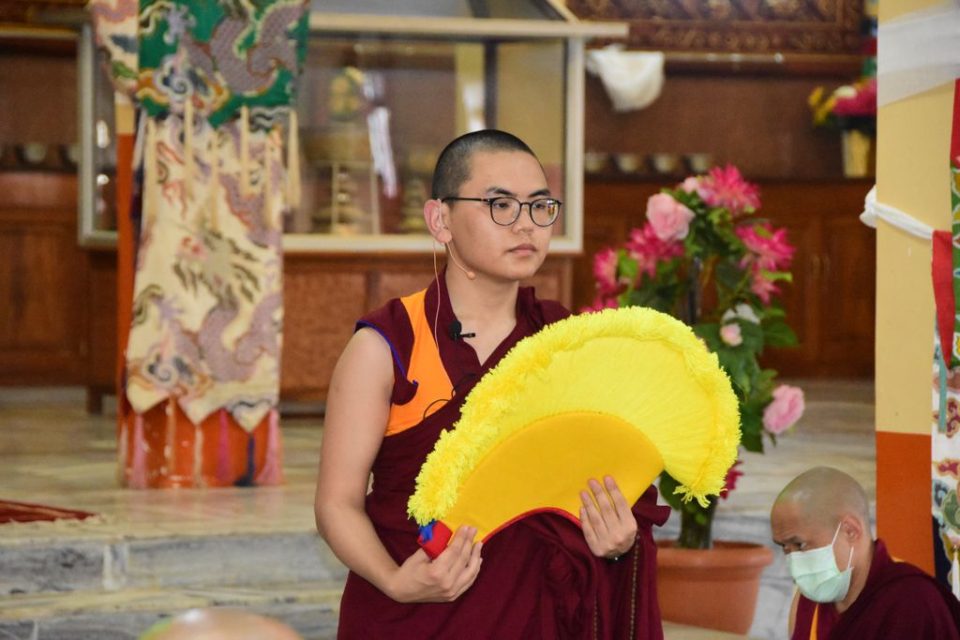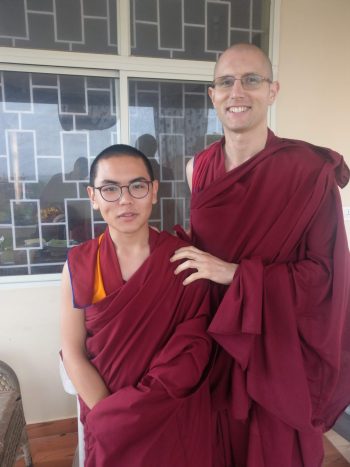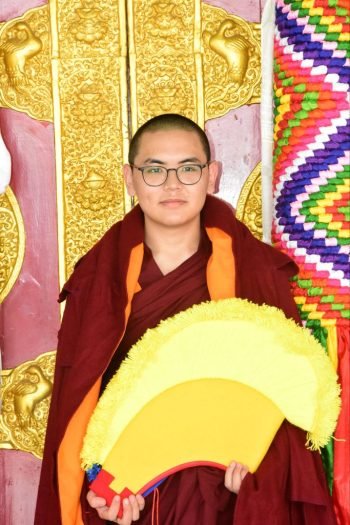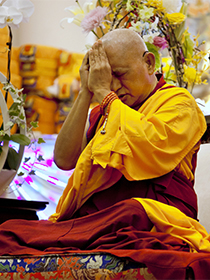- Home
- FPMT Homepage
Foundation for the Preservation of the Mahayana Tradition
The FPMT is an organization devoted to preserving and spreading Mahayana Buddhism worldwide by creating opportunities to listen, reflect, meditate, practice and actualize the unmistaken teachings of the Buddha and based on that experience spreading the Dharma to sentient beings. We provide integrated education through which people’s minds and hearts can be transformed into their highest potential for the benefit of others, inspired by an attitude of universal responsibility and service. We are committed to creating harmonious environments and helping all beings develop their full potential of infinite wisdom and compassion. Our organization is based on the Buddhist tradition of Lama Tsongkhapa of Tibet as taught to us by our founders Lama Thubten Yeshe and Lama Thubten Zopa Rinpoche.
- Willkommen
Die Stiftung zur Erhaltung der Mahayana Tradition (FPMT) ist eine Organisation, die sich weltweit für die Erhaltung und Verbreitung des Mahayana-Buddhismus einsetzt, indem sie Möglichkeiten schafft, den makellosen Lehren des Buddha zuzuhören, über sie zur reflektieren und zu meditieren und auf der Grundlage dieser Erfahrung das Dharma unter den Lebewesen zu verbreiten.
Wir bieten integrierte Schulungswege an, durch denen der Geist und das Herz der Menschen in ihr höchstes Potential verwandelt werden zum Wohl der anderen – inspiriert durch eine Haltung der universellen Verantwortung und dem Wunsch zu dienen. Wir haben uns verpflichtet, harmonische Umgebungen zu schaffen und allen Wesen zu helfen, ihr volles Potenzial unendlicher Weisheit und grenzenlosen Mitgefühls zu verwirklichen.
Unsere Organisation basiert auf der buddhistischen Tradition von Lama Tsongkhapa von Tibet, so wie sie uns von unseren Gründern Lama Thubten Yeshe und Lama Thubten Zopa Rinpoche gelehrt wird.
- Bienvenidos
La Fundación para la preservación de la tradición Mahayana (FPMT) es una organización que se dedica a preservar y difundir el budismo Mahayana en todo el mundo, creando oportunidades para escuchar, reflexionar, meditar, practicar y actualizar las enseñanzas inconfundibles de Buda y en base a esa experiencia difundir el Dharma a los seres.
Proporcionamos una educación integrada a través de la cual las mentes y los corazones de las personas se pueden transformar en su mayor potencial para el beneficio de los demás, inspirados por una actitud de responsabilidad y servicio universales. Estamos comprometidos a crear ambientes armoniosos y ayudar a todos los seres a desarrollar todo su potencial de infinita sabiduría y compasión.
Nuestra organización se basa en la tradición budista de Lama Tsongkhapa del Tíbet como nos lo enseñaron nuestros fundadores Lama Thubten Yeshe y Lama Zopa Rinpoche.
A continuación puede ver una lista de los centros y sus páginas web en su lengua preferida.
- Bienvenue
L’organisation de la FPMT a pour vocation la préservation et la diffusion du bouddhisme du mahayana dans le monde entier. Elle offre l’opportunité d’écouter, de réfléchir, de méditer, de pratiquer et de réaliser les enseignements excellents du Bouddha, pour ensuite transmettre le Dharma à tous les êtres. Nous proposons une formation intégrée grâce à laquelle le cœur et l’esprit de chacun peuvent accomplir leur potentiel le plus élevé pour le bien d’autrui, inspirés par le sens du service et une responsabilité universelle. Nous nous engageons à créer un environnement harmonieux et à aider tous les êtres à épanouir leur potentiel illimité de compassion et de sagesse. Notre organisation s’appuie sur la tradition guéloukpa de Lama Tsongkhapa du Tibet, telle qu’elle a été enseignée par nos fondateurs Lama Thoubtèn Yéshé et Lama Zopa Rinpoché.
Visitez le site de notre Editions Mahayana pour les traductions, conseils et nouvelles du Bureau international en français.
Voici une liste de centres et de leurs sites dans votre langue préférée
- Benvenuto
L’FPMT è un organizzazione il cui scopo è preservare e diffondere il Buddhismo Mahayana nel mondo, creando occasioni di ascolto, riflessione, meditazione e pratica dei perfetti insegnamenti del Buddha, al fine di attualizzare e diffondere il Dharma fra tutti gli esseri senzienti.
Offriamo un’educazione integrata, che può trasformare la mente e i cuori delle persone nel loro massimo potenziale, per il beneficio di tutti gli esseri, ispirati da un’attitudine di responsabilità universale e di servizio.
Il nostro obiettivo è quello di creare contesti armoniosi e aiutare tutti gli esseri a sviluppare in modo completo le proprie potenzialità di infinita saggezza e compassione.
La nostra organizzazione si basa sulla tradizione buddhista di Lama Tsongkhapa del Tibet, così come ci è stata insegnata dai nostri fondatori Lama Thubten Yeshe e Lama Zopa Rinpoche.
Di seguito potete trovare un elenco dei centri e dei loro siti nella lingua da voi prescelta.
- 欢迎 / 歡迎
简体中文
“护持大乘法脉基金会”( 英文简称:FPMT。全名:Foundation for the Preservation of the Mahayana Tradition) 是一个致力于护持和弘扬大乘佛法的国际佛教组织。我们提供听闻,思维,禅修,修行和实证佛陀无误教法的机会,以便让一切众生都能够享受佛法的指引和滋润。
我们全力创造和谐融洽的环境, 为人们提供解行并重的完整佛法教育,以便启发内在的环宇悲心及责任心,并开发内心所蕴藏的巨大潜能 — 无限的智慧与悲心 — 以便利益和服务一切有情。
FPMT的创办人是图腾耶喜喇嘛和喇嘛梭巴仁波切。我们所修习的是由两位上师所教导的,西藏喀巴大师的佛法传承。
繁體中文
護持大乘法脈基金會”( 英文簡稱:FPMT。全名:Found
ation for the Preservation of the Mahayana Tradition ) 是一個致力於護持和弘揚大乘佛法的國際佛教組織。我們提供聽聞, 思維,禪修,修行和實證佛陀無誤教法的機會,以便讓一切眾生都能 夠享受佛法的指引和滋潤。 我們全力創造和諧融洽的環境,
為人們提供解行並重的完整佛法教育,以便啟發內在的環宇悲心及責 任心,並開發內心所蘊藏的巨大潛能 — 無限的智慧與悲心 – – 以便利益和服務一切有情。 FPMT的創辦人是圖騰耶喜喇嘛和喇嘛梭巴仁波切。
我們所修習的是由兩位上師所教導的,西藏喀巴大師的佛法傳承。 察看道场信息:
- FPMT Homepage
- News/Media
-
- Study & Practice
-
-
- About FPMT Education Services
- Latest News
- Programs
- New to Buddhism?
- Buddhist Mind Science: Activating Your Potential
- Heart Advice for Death and Dying
- Discovering Buddhism
- Living in the Path
- Exploring Buddhism
- FPMT Basic Program
- FPMT Masters Program
- FPMT In-Depth Meditation Training
- Maitripa College
- Lotsawa Rinchen Zangpo Translator Program
- Universal Education for Compassion & Wisdom
- Online Learning Center
-
- Prayers & Practice Materials
- Overview of Prayers & Practices
- Full Catalogue of Prayers & Practice Materials
- Explore Popular Topics
- Benefiting Animals
- Chenrezig Resources
- Death & Dying Resources
- Lama Chopa (Guru Puja)
- Lama Zopa Rinpoche: Compendium of Precious Instructions
- Lama Zopa Rinpoche: Life Practice Advice
- Lama Zopa Rinpoche Practice Series
- Lamrim Resources
- Mantras
- Prayer Book Updates
- Purification Practices
- Sutras
- Thought Transformation (Lojong)
- Audio Materials
- Dharma Dates - Tibetan Calendar
- Translation Services
- Publishing Services
- Ways to Offer Support
- Prayers & Practice Materials
-
- Teachings and Advice
- Find Teachings and Advice
- Lama Zopa Rinpoche Advice Page
- Lama Zopa Rinpoche: Compendium of Precious Instructions
- Lama Zopa Rinpoche Video Teachings
- ༧སྐྱབས་རྗེ་བཟོད་པ་རིན་པོ་ཆེ་མཆོག་ནས་སྩལ་བའི་བཀའ་སློབ་བརྙན་འཕྲིན།
- Podcasts
- Lama Yeshe Wisdom Archive
- Buddhism FAQ
- Dharma for Young People
- Resources on Holy Objects
- Teachings and Advice
-
-
*If a menu item has a submenu clicking once will expand the menu clicking twice will open the page.
-
-
- Centers
-
- Teachers
-
- Projects
-
-
-
-
*If a menu item has a submenu clicking once will expand the menu clicking twice will open the page.
-
-
- FPMT
-
-
-
-
-
You must recognize that your real enemy, the thief who steals your happiness, is the inner thief, the one inside your mind – the one you have cherished since beginningless time. Therefore, make the strong determination to throw him out and never to let him back in.
Ego, Attachmnet and Liberation
Share
Lama Thubten Yeshe
-
-
-
- Shop
-
-
-
The Foundation Store is FPMT’s online shop and features a vast selection of Buddhist study and practice materials written or recommended by our lineage gurus. These items include homestudy programs, prayers and practices in PDF or eBook format, materials for children, and other resources to support practitioners.
Items displayed in the shop are made available for Dharma practice and educational purposes, and never for the purpose of profiting from their sale. Please read FPMT Foundation Store Policy Regarding Dharma Items for more information.
-
-
9

Tenzin Phuntsok Rinpoche during his rik chung debate, Sera Je Monastery, India, September 2021. Photo courtesy of Sera Je Audio/Visual Department.
Tenzin Phuntsok Rinpoche is the recognized reincarnation of Geshe Lama Konchog, a highly respected lama who passed away in 2001. Phuntsok Rinpoche was born in the Tsum region of Nepal in 2002 and enthroned in 2006 at Kopan Monastery, where he lived and attended school for a few years. Rinpoche then spent three years in Perth, Australia, where he received a Western education. He began his studies at Sera Je Monastic University in India in 2015.
Ven. Tenzin Gache, an American monk in the geshe studies program at Sera Je, has been tutoring Phuntsok Rinpoche in debate since 2016. Ven. Gache shares this story of Phuntsok Rinpoche preparing for his rik chung debate at Sera Je, which took place in September 2021, along with other stories from working with Rinpoche over seven years.
Swallowing Butterflies
Tenzin Phuntsok Rinpoche calls me at 3 p.m. to discuss bodhicitta. I ask him, “Are you nervous?”
He responds, “You know that feeling like when you swallow a can of butterflies?”
Over the course of an hour, we have a lively, often humorous discussion about the goal, the benefits, and the different kinds of bodhicitta. As usual, our conversation is a haphazard mix of English and Tibetan, often switching back and forth several times in one sentence. After fifteen years in the monastery, my spoken Tibetan is strong, but it is no match for the fluency of his English after his spending three years in a primary school in Australia.
We started our “intensive sessions” four months ago, and alternated walking across the campus to visit each other until Sera Monastery re-entered a strict lockdown and relegated all classes to the virtual realm. We are hopeful that the monastery will reopen soon, but Rinpoche knows that as soon as it does, he will have to face the most difficult trial so far in his eighteen-year life.
Becoming Tenzin Phuntsok Rinpoche’s Tutor

Tenzin Phuntsok Rinpoche with Ven. Tenzin Gache. Photo by Ven. Losang Donyo.
In 2013, Geshe Tenzin Zopa read my Mandala article “The Greatest Honor of Becoming a Rik Chung” about my experiences with a prestigious public debate in front of the Sera Je community. Intrigued that a Westerner was making inroads into this conservative Tibetan community, Geshe-la asked me if I would be able to help his young student, Phuntsok Rinpoche, to adjust to life at Sera, and tutor him in debate. I had only met Rinpoche once, very briefly, during his visit to Sera Je Kopan House in 2006, a couple months after I first arrived. Geshe-la introduced me to him again during His Holiness the Dalai Lama’s teachings at Ganden Monastery in 2014. I bent down and asked, “Rinpoche, how old are you?”
“Only twelve,” he replied and then added enthusiastically, “but next year, thirteen!”
Not long before that encounter, Osel Hita had visited us at Sera IMI House, and something he said stuck with me. Osel wanted to write a book about how to raise a tulku. The most important factor, he emphasized, is to remember that before anything else this person is a child, and like every other human being on the planet, deserves the liberty to develop their own point of view, without unrealistic expectations thrust upon them.
Becoming Tenzin Phuntsok Rinpoche’s Friend
Phuntsok Rinpoche arrived at Sera at the end of 2015, again during teachings of His Holiness the Dalai Lama. Along with my mother and Aunt Merry Colony, who were visiting for the teachings, we visited Rinpoche in his small house, a gift given by Ven. Jampa Shenphen, a Spanish monk who lived at Sera for many years. Geshe Zopa pointed out that after having finished eight years of study at Sera, I had reached a plateau from where I could comfortably cruise through the remainder of the study program. Rinpoche, on the other hand, was only just beginning, and the ascent would be a steep one. Somehow my mother got on the subject of pet cats, and Rinpoche became animated. “Can we get a cat in our house? Pleaaase?” he begged. Geshe-la reminded him that, while he was free to make such choices, he would have to recognize that he was reaching an age where he would have to take responsibility, especially because Geshe-la would be continuing to teach abroad. Geshe-la then suggested that I accompany Rinpoche to visit Lhopa Khangtsen, the house group to which I belong and which, because it was the house group of his predecessor Geshe Lama Konchok, would also be Rinpoche’s house group in this life, even though he had never visited it himself. As we walked across the campus, lively with preparations for His Holiness’s teachings, I asked Rinpoche, “Do you have any friends in Lhopa Khangtsen?”
“Only one,” he replied.
“Who?”
“You.”
As the study year commenced in March of 2016, I began making twice weekly trips to Rinpoche’s home to help him with his budding debate skills. Naturally we also talked about life in the monastery. After his childhood in Kopan Monastery—compared to Sera, a very progressive community—and his three years in Australia, life at Sera seemed almost as foreign as it had to me when I arrived. I had the sense I was tutoring a young Australian boy rather than a child of a Tibetan family living in exile in the remote regions of Nepal. His classmates in Australia had known nothing of his background, or his being a monk. He was shy about introducing them to his uncle, Geshe Zopa. When they asked if they could visit him at home, he would reply, “No, sorry. I forgot my address!”
I asked him what was his favorite subject in school. Rather shyly, he said, “Math. When I told them I liked math, the other kids called me, ‘freak of nature’!”

Tenzin Phuntsok Rinpoche outside the Sera Jey Temple after his rik chung debate. Photo courtesy of Sera Je Audio/Visual Department.
Having myself been a math prodigy as a young child, I was beginning to see that we were going to get along very well.
Developing a Point of View through Deep Investigation
Over the course of four years, our interactions took on a familiar pattern. I would visit Rinpoche on Tuesdays and Saturdays. The official subject was Buddhist dialectics, but more often than not our discussions would segue into current events, history, science, and life as a teenager. Rinpoche clearly took his role as a Buddhist monk seriously, but also had all kinds of natural questions about the deeply traditional system of the Tibetan monastery. Things came to a head in 2019, when an especially strict disciplinarian became director of Lhopa Khangtsen. He began his term with a speech outlining his new policies.
“Up until now, there’s been leniency for Injis [foreigners] and tulkus,” the disciplinarian said. Rinpoche and I looked around. There was only one Inji and one tulku in the room. “But from now on, things are going to change!”
As it happened, 2019 was Rinpoche’s fourth year of debate, and according to tradition he would have to answer the senior monks in a public debate in front of our khangtsen. The director called Rinpoche into his office. Displaying a melodramatically wistful demeanor, he reminded Rinpoche of the great lineage of Lhopa debaters. Would he be able to uphold the high standard? For two months Rinpoche and I met as much as possible to prepare. The evening of his big event, lharampa geshes stood up in succession and did their best to embarrass him. I watched as his usual shyness gave way to confidence and poise. This was the first time I had watched Rinpoche debate in public, but I had heard of his top-rate performance during the annual debate exams. It seemed that something deep within him was slowly waking up.
Over the course of the year, the director often singled the two of us out for scoldings. Rinpoche bore the challenge with grace (and, understandably, occasional panic). But one day, the director commented to Rinpoche that, “Science is dangerous. Look what it’s done to the world!” Rinpoche did not remain quiet, but responded assertively, “Well, it’s true. Atrocities have been carried out in the name of science. But you can’t say that means science is the problem. The world today is a much safer and more tolerant place as a result of advances in the past centuries. Whether something is used for good or bad depends on the mind of the person using it.” To me, his conviction in his point of view was a reflection of his having developed it through his own investigations.

Tenzin Phuntsok Rinpoche studying. Photo courtesy of Ven. Gache.
Due to the pandemic, I was stuck in Nepal during 2020, and when I finally returned in January 2021, I had not seen Rinpoche in almost a year. During my absence he had started listening to podcasts and gaining a deeper understanding of the world outside. There was a noticeable difference in our interactions—rather than my rattling off answers to his endless adolescent questions, we were engaged in a discussion.
“I hear on the news about violence in various places. But I know the news can be sensationalist. I try to see the broader perspective, to remember all the good things that don’t get reported,” he said to me. I had shared this viewpoint with him a few years ago, but now it was evidently coming from him.
At one point he asked me, “Do you think communism has ever succeeded in making the world a better place?” I told him that, while certainly the track record has been highly suspect, I keep in mind that at some level the authors of this ideology had a motivation of altruism. We got into a long talk about Marx, Lenin, Mao, and Castro. For the sake of argument, I pointed out some of the apparent successes, but Rinpoche was adamant in his position that this experiment has failed. Unlike before, he wasn’t just accepting what I said, but came back with his own opinion that he had developed.
Tenzin Phuntsok Rinpoche’s Humor and Candor
A few months later, we are discussing Shantideva’s assertion that, while trying to create positive change in the world is a worthy motivation, it is not a bodhicitta motivation unless somebody thinks beyond just this life and fathoms the reality of enlightenment. Rinpoche is preparing for his rik chung debate. As it happens, he will be in the position of “defender” for the subject bodhicitta, exactly the same position I occupied eight years ago. I have several books packed with notes from my preparations, and we have been going through these together when he has time between his rigorous training in the traditional chant he will have to perform. I ask, “What are you most nervous about? The chant or the debate?” He says, “Actually, my biggest concern is that I might trip on the dagam!” (A dagam is a heavy wool cape that he will have to wear for the ceremony.) I remember my own struggle to master all the details of the ritual, so we set aside our philosophical discussion and spend the hour thrashing out all the fine points that he is expected to perform with precision.
I never had the fortune to meet Geshe Lama Konchog. A few of the older monks in our khangtsen remember his extraordinary, almost superhuman efforts to apply the teachings into practice. While I do believe in reincarnation, I do not hold any expectations for Rinpoche to “live up” to his predecessor. I consider him a different person who will develop his own unique perspective on the Buddha’s teachings based on his extremely unconventional education path in this life, and his candor which I see as his strongest quality. Rinpoche himself always keeps a tongue-in-cheek attitude about his relation with Geshe Konchog. At the end of 2019, I brought two young Singaporean boys to meet him in his home. Motioning to the small shrine in his living room, he says matter-of-factly, “Well, that was me!”
One of the boys, Tashi, asks rather inelegantly, “When did you die?”
Rinpoche plays along. “I died in 2001. You see, I’m really a ghost!”
Ven. Tenzin Gache (Brian Roiter) grew up in the Boston area of the United States. He was ordained by His Holiness the Dalai Lama in 2005 and began studying at Sera Je Monastary in 2006. He is nearing the end of the regular course of study for the degree of geshe and aspires to attend the additional six-year round of Gelug examinations to qualify for the degree of lharampa.
- Home
- News/Media
- Study & Practice
- About FPMT Education Services
- Latest News
- Programs
- New to Buddhism?
- Buddhist Mind Science: Activating Your Potential
- Heart Advice for Death and Dying
- Discovering Buddhism
- Living in the Path
- Exploring Buddhism
- FPMT Basic Program
- FPMT Masters Program
- FPMT In-Depth Meditation Training
- Maitripa College
- Lotsawa Rinchen Zangpo Translator Program
- Universal Education for Compassion & Wisdom
- Online Learning Center
- Prayers & Practice Materials
- Overview of Prayers & Practices
- Full Catalogue of Prayers & Practice Materials
- Explore Popular Topics
- Benefiting Animals
- Chenrezig Resources
- Death & Dying Resources
- Lama Chopa (Guru Puja)
- Lama Zopa Rinpoche: Compendium of Precious Instructions
- Lama Zopa Rinpoche: Life Practice Advice
- Lama Zopa Rinpoche Practice Series
- Lamrim Resources
- Mantras
- Prayer Book Updates
- Purification Practices
- Sutras
- Thought Transformation (Lojong)
- Audio Materials
- Dharma Dates – Tibetan Calendar
- Translation Services
- Publishing Services
- Teachings and Advice
- Find Teachings and Advice
- Lama Zopa Rinpoche Advice Page
- Lama Zopa Rinpoche: Compendium of Precious Instructions
- Lama Zopa Rinpoche Video Teachings
- ༧སྐྱབས་རྗེ་བཟོད་པ་རིན་པོ་ཆེ་མཆོག་ནས་སྩལ་བའི་བཀའ་སློབ་བརྙན་འཕྲིན།
- Podcasts
- Lama Yeshe Wisdom Archive
- Buddhism FAQ
- Dharma for Young People
- Resources on Holy Objects
- Ways to Offer Support
- Centers
- Affiliates Area
- Teachers
- Projects
- Charitable Projects
- Make a Donation
- Applying for Grants
- News about Projects
- Other Projects within FPMT
- Support International Office
- Projects Photo Galleries
- Give Where Most Needed
- FPMT
- Shop
Translate*
*powered by Google TranslateTranslation of pages on fpmt.org is performed by Google Translate, a third party service which FPMT has no control over. The service provides automated computer translations that are only an approximation of the websites' original content. The translations should not be considered exact and only used as a rough guide.When you meet miserable conditions, it is extremely important to use skillful means. In other words, there is a meditation to mix with whatever suffering you experience. When you apply the teachings in this way, all sufferings are mixed with virtue. All experiences of suffering become virtue.








